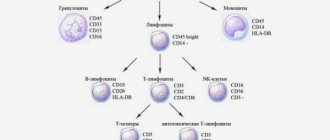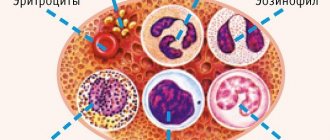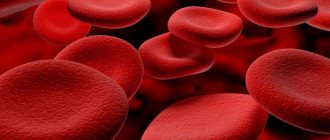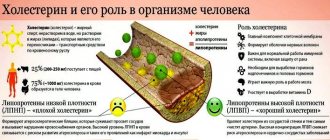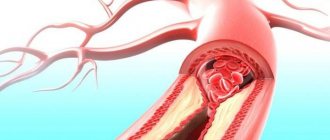Total protein in blood serum is the total concentration of albumin and globulin in the liquid component of blood, expressed quantitatively. This indicator is measured in g/liter.
Protein and protein fractions are composed of complex amino acids. Blood proteins take part in various biochemical processes in our body and serve to transport nutrients (lipids, hormones, pigments, minerals, etc.) or medicinal components to various organs and systems.
They also act as catalysts and provide immune defense for the body. Total protein serves to maintain a constant pH in the circulating blood and takes an active part in the coagulation system. Due to protein, all blood components (leukocytes, erythrocytes, platelets) are present in the serum in suspension. It is the protein that determines the filling of the vascular bed.
Based on total protein, one can judge the state of hemostasis, because Due to protein, blood has such characteristics as fluidity and has a viscous structure. The functioning of the heart and the cardiovascular system as a whole depends on these qualities of blood.
The study of total blood protein refers to biochemical analysis and is one of the main indicators for diagnosing various diseases; it is also included in the mandatory list of studies during clinical examination for some groups of the population.
Norms of protein concentration in blood serum of various age categories:
| category | Norma/women | Norma/ men |
| Newborns | 42-62 g/l | 41-63 g/l |
| Children under 1 year | 44-79 g/l | 47-70 g/l |
| Children from 1 year to 4 years | 60-75 g/l | 55-75 g/l |
| Children from 5 years to 7 years | 53-79 g/l | 52-79 g/l |
| Children from 8 years to 17 years | 58-77 g/l | 56-79 g/l |
| Adults 22-34 years old | 75 - 79 g/l | 82-85 g/l |
| Adults 35-59 years old | 79-83 g/l | 76-80 g/l |
| Adults 60-74 years old | 74-77 g/l | 76-78 g/l |
| Over 75 years old | 69-77 g/l | 73-78 g/l |
Total blood protein is required to be determined during diagnosis:
- kidney diseases, liver diseases
- acute and chronic infectious processes of various types
- burns, cancer
- metabolic disorders, anemia
- nutritional disorders and exhaustion, gastrointestinal diseases - to assess the degree of malnutrition
- a number of specific diseases
- as stage 1 in a comprehensive examination of the patient’s health status
- to assess the body's reserves before surgery, medical procedures, taking medications, the effectiveness of treatment and determine the prognosis of the current disease
Readings of total blood protein make it possible to assess the patient’s condition, the function of his organs and systems in maintaining proper protein metabolism, and also determine the rationality of nutrition. In case of deviation from the normal value, the specialist will prescribe further examination to identify the cause of the disease, for example, the study of protein fractions, which can show the percentage of albumin and globulins in the blood serum.
Deviations from the norm may be:
- Relative deviations are associated with changes in the amount of water in the circulating blood, for example, during infusions or, conversely, with excessive sweating.
- Absolute are caused by changes in the rate of protein metabolism. They can be caused by pathological processes that affect the rate of synthesis and breakdown of serum proteins or physiological processes, such as pregnancy.
- Physiological deviations from the norm of total protein in the blood serum are not associated with the disease, but can be caused by the intake of protein foods, prolonged bed rest, pregnancy, lactation, or changes in water load and heavy physical work.
Indications for analysis
Changes in the amount of protein contained in plasma occur for various reasons. It can change as a result of certain processes, for example, pathological ones. That is why the main way to diagnose any disease is a general blood test for protein. This helps to assess the condition of the body, the extent of the spread of the inflammatory process and prescribe the necessary treatment. What does a protein blood test show and when is it prescribed?
The main indications for the blood sampling procedure include:
- Chronic or acute viral diseases.
- Burns of varying degrees.
- Digestive system disorders.
- Suspicion or diagnosis of cancer.
- Diseases of the urinary system.
- Screening examinations.
- Systemic diseases.
The presence of these pathologies or the suspicion of their presence is the primary reason for prescribing a general blood test for the content of protein substances.
What does a decrease in the concentration of total protein in the blood serum indicate?
Reduced levels of total protein in the blood are called hypoproteinemia. This condition can be observed during pathological processes, for example, such as:
- parenchymal hepatitis
- chronic bleeding
- anemia
- loss of protein in urine in kidney disease
- diets, fasting, insufficient consumption of protein foods
- increased protein breakdown associated with metabolic disorders
- intoxications of various types
- fever.
Special mention should be made of physiological hypoproteinemia, i.e. conditions not associated with the course of pathological processes (disease). A decrease in total protein in the blood can be observed:
- in the last trimester of pregnancy
- during lactation
- during prolonged heavy loads, for example when preparing athletes for competitions
- with prolonged physical inactivity, for example, in bedridden patients
Symptomatically, a decrease in the concentration of total protein in the blood can be expressed by the appearance of tissue edema. This symptom usually appears with a significant decrease in total protein, below 50 g/l.
When is verification necessary?
A blood test is carried out in the following cases - in case of liver disease, in case of renal pathology, collagenosis and oncological diseases. In addition, testing is required for serious infectious diseases, nutritional disorders and scoring examinations.
Before carrying out medical procedures, operations, taking medications or when determining the prognosis of a disease, protein in the blood is also measured, the norm of which indicates readiness (or unpreparedness) for certain manipulations.
What does an increase in total protein in the blood serum indicate?
A significant increase in the concentration of total protein in the blood is called hyperproteninemia. This condition cannot be observed during normal physiological processes, and therefore develops only in the presence of pathology, in which pathological proteins are formed.
For example, an increase in total protein in the blood may indicate the development of an infectious disease or a condition in which dehydration occurs (burns, vomiting, diarrhea, etc.).
An increase in total protein cannot be accidental; in this case, it is recommended to seek help from a doctor as soon as possible for further examination. Only a specialist can establish the cause, make a correct diagnosis and prescribe effective treatment.
Diseases in which there is a decrease and increase in total protein in the blood:
| Reduced total blood protein | Elevated total blood protein |
|
|
What does increasing protein levels mean?
What does an increase in protein levels mean?
Exceeding the content of substances in the blood is less common in medical practice. This is usually associated with quite serious pathologies and indicates the presence of:
- Severe or chronic illnesses.
- Lack of fluid in the body, which appears as a result of prolonged vomiting, diarrhea, diarrhea, burns, intestinal obstruction, nephritis and many other pathologies.
- Autoimmune diseases, for example, systemic lupus erythematosus, reactive arthritis, active chronic hepatitis, glomerulonephritis.
- Malignant formations accompanied by the production of harmful reactive proteins.
A blood test for protein, which should only be deciphered by highly qualified doctors, can show abnormalities in the functioning of many body systems.
How to prepare for biochemical tests?
- Taking biochemical tests, including total protein, does not require special preparation, but you should remember that they are taken in the morning on an empty stomach. The previous meal should be no later than 8, and preferably 12, hours before the procedure.
- The day before the test, it is better not to eat a lot of protein foods.
- Don't drink too much liquid
- Avoid strenuous physical activity.
All these factors can influence the true result of the analysis in one direction or another.
9 minutes Author: Lyubov Dobretsova 2990
Hypoproteinemia - a condition when total protein in the blood is low - is detected during a biochemical study. Unregulated content of protein and protein fractions is a clinical diagnostic sign of pathological disorders in the liver, renal apparatus, and endocrine system.
High molecular weight proteins (proteins) in the blood are organic substances with a high concentration of amino acids - the main regulators of the body's nitrogen balance. Proteins play the role of a building foundation for cells and take an active part in all biochemical processes.
They are the basis of enzymes and an integral part of hormones. After proteins enter the body, they are broken down into essential and non-essential amino acids, which become the basis for the body’s production of its own proteins.
The functional purpose of protein fractions and total protein is:
- moving oxygen from the lungs to tissues, transporting carbon dioxide in the opposite direction and creating an oxygen reserve;
- maintaining immunity;
- preservation of amino acid reserves;
- ensuring molecular compression to maintain constant colloid-osmotic pressure - an indicator of water metabolism;
- protection of erythrocytes (red blood cells) from premature destruction;
- protecting the inner wall of blood vessels by neutralizing “bad cholesterol”;
- maintaining normal blood clotting;
- participation in the construction of new proteins in muscle tissue;
- transport of nutrients and drugs through the bloodstream.
The normal amount of proteins is an indicator of homeostasis (the body’s ability to maintain a constant internal environment).
Total information
Total protein is the total amount of all protein compounds in blood plasma, which include antibodies, enzymes, hormones, reactive protein, and so on. They all perform a huge number of different functions, which is why total protein is so important when making a diagnosis and it is necessary to periodically do biochemistry.
Total protein is designated as tp, as it has international significance - Total Protein.
Proteins in blood tests and content standards
A biochemical blood test is prescribed for the primary diagnosis of diseases, for the purpose of monitoring therapy, as part of routine examinations of the population. The study includes more than 20 blood parameters that reflect the health of the body. In addition to the quantitative content of total protein, the analysis takes into account indicators of albumin, globulins, fibrinogen, etc.
Direct indications for checking protein levels in the blood are:
- liver and kidney diseases (acute and chronic)
- diagnosed oncopathologies, infections, diseases of the digestive system;
- anemia (anemia of various origins).
The results of the study are compared with reference values accepted for laboratory diagnostics. The measurement is made in g/l. In childhood, total protein levels are variable. The indicators stabilize by the age of 16 and remain until old age. A slight decrease in the concentration of protein compounds is allowed in people who have crossed the sixty-year mark, which is associated with general age-related changes in the body.
| Newborns | Up to six months | Up to a year | From one to 3 years | From 3 to 16 years |
| 46–70 | 44–76 | 51–73 | 56–75 | 60–80 |
Reference values for adults range from 64 to 86 g/l. At the age of 60+, non-pathological indicators are considered to be from 61 to 80 g/l. There are no differences in protein content standards based on gender. The exception is the perinatal period in a woman’s life, when the quantitative value of albumin and globulins decreases.
A decrease in protein level by more than 10 grams is grounds for additional examination. The critical value is to reduce the protein concentration by half (from the norm). The content of total protein in the blood depends on the synthesis and breakdown of albumin produced by the liver and globulins (α-globulins and β are synthesized in the liver, γ-globulins in lymphocytes).
Elevated protein levels are rarely detected, but just like decreased ones, they are considered abnormal. A marker of the inflammatory process is high levels of C-reactive protein (CRP).
Blood test for C reactive protein
Analysis for C reactive protein allows you to quickly determine the presence of neoplasms and infections, and also helps to monitor and adjust treatment and is the second most important indicator. The norm is considered to be not more than 0.5 mg/l. Exceeding the value indicates that the body is developing cancer, gastrointestinal diseases, tuberculosis or meningitis.
C reactive protein serves as an indicator of inflammatory processes and a stimulator for immune processes. This analysis is no less important than a biochemical blood test for protein.
Main causes of hypoproteinemia
Why do total protein levels drop? Its content in the blood can be influenced by physiological factors (individual characteristics and temporary physical changes) and pathological factors associated with serious disturbances of biochemical processes and the presence of diseases.
Non-pathological factors of protein reduction
Physiological hypoproteinemia occurs in the following cases:
- Dehydration (dehydration) of the body caused by prolonged exposure to high temperatures with symptoms of overheating (vomiting, diarrhea);
- Perinatal period. Due to the need to ensure the vital functions of two organisms at once, in pregnant women the volume of blood increases, which becomes less concentrated. The permissible reduction is about 5 to 9 g/l.
- An unbalanced diet, adherence to an incorrect nutrition system (protein-free diets, veganism) and fasting. An insufficient amount of protein supplied from food causes a deficiency of amino acids necessary for the synthesis of its own protein.
- Excessive sports and other physical activity. With increased physical activity, the consumption of all nutrients increases, including the protein component of the blood.
Hypoproteinemia is observed with prolonged immobilization in patients forced to remain in bed.
Dangerous causes of hypoproteinemia
Pathological causes of low protein are due to latent or progressive development of diseases of internal organs, impaired synthesis of biologically active substances, and unfavorable heredity. Pathologies include:
- destruction and death of hepatocytes (liver cells), due to cirrhosis, hepatitis, hepatosis.
- water intoxication (overhydration), which occurs due to hypersynthesis of the antidiuretic hormone vasopressin in the nuclei of the hypothalamus (excess vasopressin is dangerous for the development of cerebral edema and coma)
- hypervolemia (increase in circulating blood volume) due to water retention in the vascular bed;
- accumulation of fluid in the pleural cavity of the lungs (exudative pleurisy), in the alveoli (pulmonary edema);
- cachexia (extreme exhaustion of the body), the causes may be aggressive diets, severe infectious and inflammatory diseases, anorexia;
- primary immunodeficiencies (hereditary) and secondary (HIV, AIDS, etc.);
- diabetes mellitus in the stage of subcompensation and decompensation;
- thyroid hormonal imbalance;
- PTH – late toxicosis of pregnancy (preeclampsia);
- oncohematological diseases (malignant lesions of the circulatory and lymphatic systems);
- severe stages of anemia (anemia);
- accumulation of fluid in the abdominal cavity (ascites) as a complication of chronic liver pathologies, cancers of other organs of the gastrointestinal tract (gastrointestinal tract);
- impaired production of pancreatic enzymes (pancreatic enzyme insufficiency);
- malabsorption and other intestinal pathologies associated with protein malabsorption;
- thermal, chemical, electrical burns of a wide area and depth;
- volumetric bleeding (external, due to trauma or injury, and hemorrhage of internal organs);
- proteinuria (the presence of protein in the urine caused by diseases of the renal system).
If there are no physiological reasons for a decrease in total protein a priori, it means that a disturbance in the composition of the blood is provoked by the presence of a pathological process. Unsatisfactory results of biochemical analysis are the basis for rechecking and conducting advanced diagnostics.
What is the norm?
The norm of proteins is explicated in different ways.
The following classification is given by type of protein fraction:
| Protein, total (g/l): | Albumin (g/l): | Fibrinogens (g/l): | Globulin: |
| from 64 to 84; | from 35 to 55; | from 2 to 4; | explicated if necessary and by fractions. |
There is also a table of protein content values by age:
| Children under one month (g/l): | Children under one year (g/l): | Children under 5 years old (g/l): | 5-20 years (g/l): | Over 20 years (g/l): |
| from 48 to 73; | from 47 to 72; | from 31 to 75; | from 58 to 76; | from 65 to 85. |
It is worth noting that the values will differ for women during pregnancy, lactation, and menstruation. During these processes, it is extremely necessary to monitor the levels of various substances in the blood, since otherwise a situation may arise that is potentially dangerous to the life of the mother, fetus or child.
Symptomatic manifestations of hypoproteinemia
A drop in protein levels is not characterized by clear specific symptoms. Somatic and external manifestations of low protein in the blood depend on the disorders and diseases that provoked changes in blood composition. With a slight loss of proteins, weakness, decreased physical capabilities, and CFS (chronic fatigue syndrome) are observed.
With a more serious decrease in indicators, the following manifestations are added:
- dysania (sleep disorder), apathy, irritability;
- unstable functioning of the digestive and urinary system;
- frequent ARVI and colds;
- labored breathing;
- suppression of libido (sexual desire);
- hypertensive symptoms (increased blood pressure, headache).
An external sign is swelling (accumulation of excess fluid in the extracellular space). Edema occurs due to a violation of the stable level of colloid-osmotic and hydrostatic pressure on the walls of blood vessels, since an insufficient number of protein molecules cannot provide the necessary compression for the passage of water from the tissue fluid into the bloodstream.
A reduced level of protein inhibits the process of formation of new cells, therefore the processes of post-traumatic skin restoration are disrupted. Trying to make up for the lack of proteins, the body begins to pull them from muscle fibers, which leads to their destruction. The symptoms are:
- arthralgia – muscle pain not caused by physical stress or inflammatory processes;
- weight loss (due to muscle mass).
Lack of nutrients affects the health of hair and nails (brittleness, dryness, etc.). Hypoproteinemia can only be determined through a laboratory blood test. To do this, you need to donate blood for a biochemical analysis. Blood sampling is carried out free of charge upon referral from a doctor. You can undergo the procedure yourself for a fee at clinical diagnostic centers.
Why might its level be increased?
There may be several reasons for increased protein levels in the blood.
A critically high level can be provoked by:
- autoimmune diseases;
- chronic inflammatory processes;
- acute infections;
- oncology.
Relatively high levels are provoked by:
- infectious intestinal diseases;
- food and non-food poisoning;
- bleeding, previous surgical interventions;
- drug overdose.
It is worth noting that they often write on the Internet or other unverified sources about the benefits of a protein diet. It is described that consuming protein in large quantities and reducing the consumption of fat and carbohydrate foods has a beneficial effect on the body, leads to weight loss, etc.
In fact, excess protein in food disrupts the functioning of many systems; moreover, it is not entirely rationally consumed by the body and is not fully absorbed. Among other things, this disrupts the overall composition of the blood.
Ways to restore protein levels
The main condition for replenishing protein deficiency is an accurate diagnosis of the cause of the disorder. A pathological drop in protein levels in the blood requires treatment of the underlying disease. With physiological loss, correcting eating habits helps increase protein in the blood.
You should increase the amount of protein foods in your daily diet. In this case, it is necessary to maintain a balance of proteins of plant and animal origin, since they contain different amino acids necessary for the body.
| Plant proteins | Animal proteins | ||
| seeds | pumpkin and sunflower | meat | liver (pork, beef), veal, beef heart, rabbit |
| nuts | peanuts, walnuts, pistachios, almonds, hazelnuts | bird | chicken, turkey |
| legumes | beans (white and red), peas, soybeans, lentils | fish | tuna, burbot, perch, hake, saury, sardine, mackerel, salmon, caviar (any) |
| grains and cereals | oats, buckwheat, millet, rice (brown) | ||
| mushrooms | white dried | milk products | cheese, cottage cheese, feta cheese |
| seaweed | kelp (sea kale) | ||
| vegetables and root vegetables | cabbage (kohlrabi, Brussels sprouts), spinach, potatoes | seafood | shrimp, crabs, squid, mussels |
When introducing an increased amount of protein into the menu, one should not forget about the carbohydrate component. The diet should be balanced. Excessive consumption of protein foods can negatively affect the functioning of the digestive system.
Dyspepsia (difficult and painful food processing), obstipation (constipation), heaviness in the epigastric (epigastric) region, and nausea often occur. In addition, many protein foods are high in energy value and contain animal fat, which contributes to weight gain.
For proper absorption of proteins, increasing body tone and immunity, it is recommended to take vitamin and mineral complexes (Alphabet, Pikovit, Duovit, Complivit, etc.). You can increase the level of total protein with the help of special medications. The decision on drug treatment for hypoproteinemia should be made by the doctor.
As for special supplements (protein shakes and protein bars), it should be borne in mind that they are designed for people who are actively involved in sports. The bars contain a large amount of fat and sugar, which is not the best for health if the excess calories are not burned through exercise.
Results
A decrease in total protein levels is an abnormal condition. The following physiological reasons can provoke the problem:
- poor nutrition;
- pregnancy;
- grueling physical activity.
A properly organized diet helps compensate for protein deficiency. It is necessary to increase the volume of foods high in plant and animal proteins in the daily menu. In the absence of the influence of physiological factors, low protein in the blood is a clinical diagnostic sign of dysfunction of the liver and kidneys, water intoxication of the body, and pathologies of the digestive tract.
Determination of the quantitative protein content is carried out using a biochemical blood test. For adults, indicators should fall within the range of 64–86 g/l. If the values decrease significantly, the patient should be prescribed an additional examination in order to identify the specific causes of the blood disorder.
When conducting a biochemical blood test, a specialist pays special attention to the content of total protein. Any deviation from standard indicators may be a sign of various hidden diseases occurring in the human body.
Protein is a kind of indicator of health, and its decrease may indicate malfunctions in the functioning of organs and systems. What is the name of the condition when total protein in the blood is low, what pathologies does such a disorder signal, and how can this indicator be brought back to normal?
Blood chemistry
A biochemical analysis is a subtype of a general blood test and is carried out in cases where deviations from normal values were detected in a general blood test. The analysis allows you to clarify the diagnosis or adjust the prescribed treatment. In a biochemical blood test, the designations are a letter abbreviation or a general name for the indicator. Let's consider the decoding of the designations of a biochemical blood test:
- Total protein . It represents the total amount of proteins in the blood; it is involved in blood clotting and the transport of various substances to organs and tissues. Normally it corresponds to values of 64-84 g/l. Exceeding the norm may indicate infections, arthritis, and cancer.
- Glu - glucose . Normally it does not exceed 3.30-5.50 mmol/l. An increase in the indicator signals the development of diabetes mellitus. In the body, glucose is responsible for carbohydrate metabolism.
- Urea . Formed during the breakdown of proteins. Normally it is 2.5-8.3 mmol/l. The value of the indicator increases with kidney diseases, intestinal obstruction, and diseases of the urinary system.
- LDL and HDL indicate the level of cholesterol in a biochemical blood test, which takes part in fat metabolism, the production of vitamin D, and affects the functioning of sex hormones. The normal limits are 3.5-6.5 mmol/l. This indicator increases with atherosclerosis, cardiovascular diseases, and liver diseases.
- BIL - bilirubin. The pigment is red-yellow in color and is formed after the breakdown of hemoglobin. Total bilirubin consists of indirect and direct bilirubin and normally corresponds to values of 5-20 µmol/l. A strong increase in the indicator indicates a lack of vitamin B12, the development of jaundice, and cancer.
- Creatinine . It is an indicator of kidney function and takes part in the energy metabolism of tissues. The normal level depends on the person’s body weight and is 53-115 µmol/l. As a rule, an increase in this indicator indicates renal failure.
- α-amylase, amylase - amylase. Promotes the breakdown and digestion of carbohydrates. The normal value for α-amylase is 28-100 units/l, for pancreatic amylase – 0-50 units/l. An increase in the indicator may indicate peritonitis, pancreatitis, diabetes mellitus and some other diseases.
- lipase - lipase. Pancreatic enzyme that breaks down fats. Normally it does not exceed 190 units/l. When deciphering the designations of a biochemical blood test, an increase in the indicator will indicate the development of pancreatic diseases.
- ALT (ALT) – alanine aminotransferase. A special enzyme used to diagnose liver function. ALT appears in the blood if the cells of the liver, heart, and kidneys are destroyed. Normally, the indicator should not exceed 41 units/l. in men and 31 units/l. among women.
Characteristics of the indicator
Total protein is an important component of protein metabolism in the body.
Protein is considered a building material that is simply necessary for all organs and systems of the human body. It, like a frame, forms the basis on which all cells and molecular structures of other types of metabolism are subsequently attached. In other words, protein is the main building material, without which it is simply impossible to restore the structure of cells and tissues.
Total serum protein is the concentration of albumin and globulin in the fluid component of blood. The building blocks of protein and protein functions are complex amino acids. Proteins are actively involved in various biochemical processes occurring in the human body. In addition, they serve to transport nutrients such as hormones, pigments, lipids and minerals.
Proteins are a kind of catalysts, and they are responsible for the immune function of the body.
Total protein helps maintain a constant pH environment in the blood circulating in the body and is actively involved in the coagulation system. Due to the presence of protein in the human body, all components of the blood are contained in the serum in a suspended state.
Based on the indicators of total protein, we can talk about the state of hemostasis, since thanks to this element the blood has such characteristics as fluidity and viscosity. Thanks to such qualitative characteristics of blood, the heart and the entire cardiovascular system as a whole work normally. Most often, in pathologies, the concentration of protein in the blood is reduced and this pathological condition is called hypoproteinemia.
Diagnostics and norms of the indicator
Blood sampling procedure to test total protein levels
Indications for determining blood protein are diagnostics:
- pathologies of the kidneys and liver
- repeated chronic infections
- burns and malignant neoplasms
- various specific pathologies
- diseases of the gastrointestinal tract
- malnutrition and varying degrees of malnutrition
- anemia and metabolic disorders
In addition, identification of total protein and its concentration is carried out as the 1st stage of preparation for a comprehensive health examination. Such a study may be prescribed in order to assess the body's reserves before undergoing surgery, various medical procedures and before taking medications.
In addition, the indication for determining total protein is the need to assess the effectiveness of the therapy and the prognosis of the current pathology.
Total protein standards:
- In newborns, the normal level of protein in the blood is considered to be 45-70 g/l.
- Over the next 15 years, this figure increases to a level of 60-80 g/l.
- In adult patients under 60 years of age, the level of this compound in the blood reaches 65-85 g/l.
- After 60 years, the indicator of such organic matter decreases to 62-81 g/l.
In some cases, a person may experience slight deviations from the norm downward, and this may occur under the influence of the following factors:
- severe dehydration
- breastfeeding period
- pregnancy
- Insufficient protein intake from food
- taking certain types of medications
- strong physical stress on the body
The level of protein in the human body can be determined using a biochemical analysis, which is carried out in the morning and always on an empty stomach. The last meal before the study should be no later than 8-12 hours. On the day of the test, it is recommended not to eat too much protein food, not drink a lot of fluids and avoid heavy physical activity on the body. The fact is that all these factors can affect the final result of the study in one direction or another.
Reasons for the decline
Along with an increase in the level, a decrease may occur. This process is called hypoproteinemia. A decrease in the indicator is much more common and can also be absolute or relative. The reason for the second can only be excessive consumption of water - hydremia. The detection of this change is most often caused by severe thirst, which is considered one of the main signs of diabetes mellitus or diabetes insipidus.
The reasons for an absolute decrease in protein concentration in the blood can be:
- long-term abstinence from food;
- the predominance of low protein foods in the diet;
- narrowing of the esophagus;
- pathologies of the gastrointestinal tract;
- liver pathologies;
- prolonged fever;
- high body temperature;
- burns and frostbite;
- heavy physical activity;
- exudative inflammation;
- serious injuries;
- kidney pathologies.
A decrease in protein levels relative to normal can be triggered by physiological processes. For example, it can occur in women during pregnancy, in particular after 32 weeks. Also, a downward trend is typical for nursing women and newborns. With large volumes of intravenous administration of blood thinning drugs, hypoproteinemia may occur. The situation normalizes after removing excess fluid from the body.
Fluctuations in protein levels in the blood allow us to conclude that inflammatory processes are occurring in the body or there are chronic pathological conditions. It is impossible to make a diagnosis with just a blood test for protein, but the data obtained will help determine the direction of further examination and, accordingly, treatment.
Causes of low blood protein
Low protein levels may be a sign of liver disease
In medical practice, such a pathology as a decrease in protein levels in the blood is called hypoproteinemia.
Its presence can signal some diseases and disorders occurring in the human body:
- hepatic cell failure, which developed against the background of acute and chronic liver pathologies
- improper and irrational nutrition in the absence of any pathologies affecting internal organs
- depletion of the human body, which is caused by long-term diseases and infectious-purulent inflammations
- various pathologies of pregnancy, for example, gestosis
- diseases of the endocrine system, that is, decreased thyroid function and hyperfunction of the adrenal glands
- HIV infection and various immunodeficiencies
- disruption of the pancreas with its enzymatic insufficiency
- diabetes mellitus with various complications
- severe form of anemia, malignant neoplasms and bleeding;
- accelerated excretion of protein from the body along with urine in severe kidney diseases and renal failure
- pathologies of the stomach and intestines in a chronic form, which are accompanied by disruption of the digestion process and absorption of protein components from food
A symptomatic decrease in the level of total protein in the human body can be expressed in the formation of tissue edema. Typically, this symptom is observed with a significant decrease in total protein, that is, below 50 g/l.
A decrease in protein concentration in the blood is always considered a dangerous signal, which indicates various pathological changes. The human body, which is in this state, becomes completely defenseless to the effects of various unfavorable factors and is not able to recover on its own.
Functions of protein in the human body
Biochemical analysis performed in the laboratory allows us to determine the content of protein molecules in human plasma. The protein level indicates amino acid metabolism and determines the performance of recovery functions. Protein is the basis for the functionality of all cells. If the protein concentration is too high or, conversely, insufficient, the functioning of all organs will be disrupted, and this will negatively affect the overall well-being of a person.
There are many different protein molecules in the body, their synthesis occurs in the liver. In order to produce protein in the required quantity, it is necessary to monitor the condition of the liver.
Protein compounds contain several main components:
- Globulin. This is a large molecular protein that is responsible for supporting the immune system. The substances included in its composition are necessary for the synthesis of protein and antibodies. Globulin kills harmful microorganisms, viruses and bacteria.
- Abbot. Low molecular weight protein, which is a basic element in the structure of body cells. Compared to the total amount of protein, the volume of this type is more than half.
- Fibrinogen is a high molecular weight protein that is responsible for blood clotting. If this protein increases, the risk of thromboembolism increases. Fibrinogen occupies a smaller part of the protein volume.
Proteins in the circulatory system perform the following functions:
- strengthen the immune system, restore organs after damage and injury
- responsible for the metabolic process in tissues and organs
- nutrients, microelements and oxygen are distributed and carried throughout the circulatory system and the body
- promote the accumulation of amino acids
- actively fight viral bacteria
- regulate blood clotting and viscosity, thereby normalizing blood pressure
Even with minor diseases, protein concentrations deviate downward or upward. To normalize it, it is important to determine the cause of the pathological condition, and then perform appropriate treatment.
